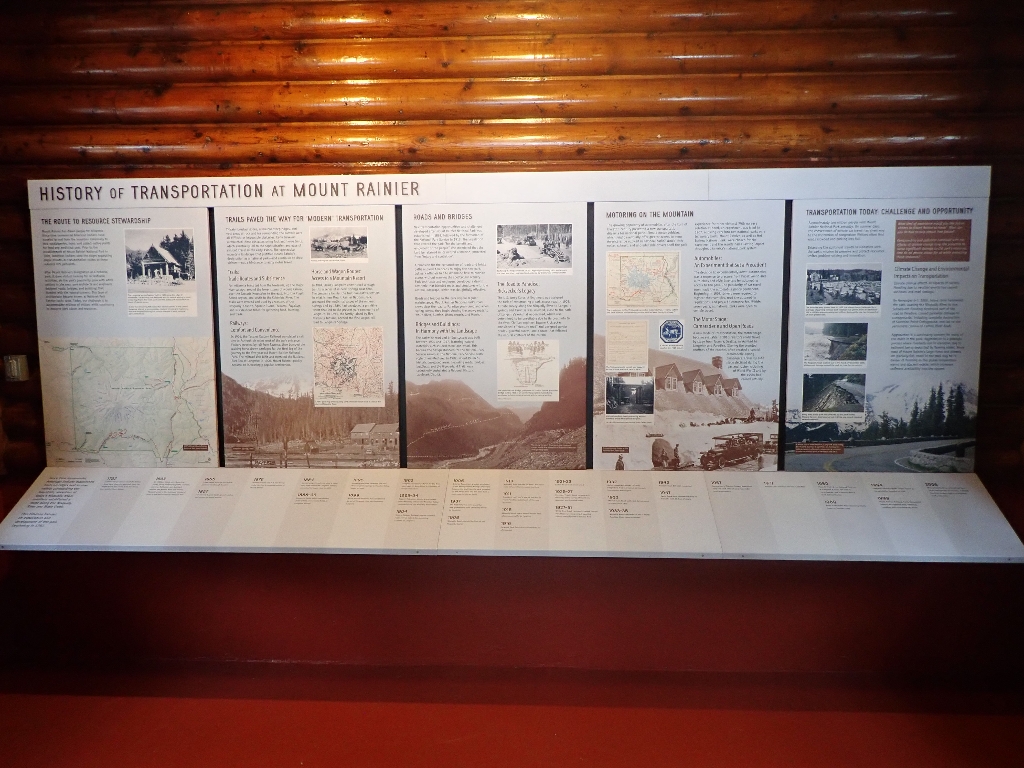
Season: Year-round
Longmire is located in the southwest corner of Mount Rainier National Park and is 6.5 miles (10.5 km) east of the Nisqually Entrance. The Transportation Exhibit is located inside the historic Longmire Service Station, which is next to the National Park Inn. The exhibit is open daily when the Longmire Museum is open. The exhibit panels are attached to the wall across from the door and consist of five panels with a timeline stretching across the bottom of the panels.
History of Transportation at Mount Rainier
Panel 3 Title: Roads and Bridges
Panel 3 Main Text
New transportation opportunities and challenges developed after Mount Rainier National Park was established in 1899, followed by the formation of the National Park Service in 1916. The legislation that created the park “for the benefit and enjoyment of the people” also mandated that the land be retained in its natural condition, protected from “injury and spoliation”.
A provision for the construction of roads and bridle paths allowed Americans to enjoy the new park, but park officials had to determine how to provide access without marring the spectacular scenery. Park architects and engineers developed a design aesthetic that blended roads and structures with the natural landscape, which was delightfully effective.
Roads and bridges in the park require regular maintenance. Mount Rainier National Park’s road crews clear the road to Paradise year-round and when spring comes, they begin plowing the snowy roads to White River, Sunrise, Ohanapecosh, and Mowich.
The Road to Paradise: Ricksecker’s Legacy - The U.S. Army Corps of Engineers was assignedthe task of constructing a park access road in 1903. A route survey along the Nisqually River to Longmire Springs and Paradise was selected, close to the path of Longmire’s original wagon road, which was determined to be unsuitable due to its proximity to the river. Civilian engineer Eugene Ricksecker envisioned a “pleasure road” and designed gentle grades, graceful curves, and a route that followed the natural contours of the terrain.
Bridges and Buildings: In Harmony with the Landscape - The parkwide road and bridge system was built between 1920 and 1957, featuring natural materials such as local stone and wood. This became the design standard for the National Park Service known as the National Park Service rustic style of architecture. In 1997, Mount Rainier’s historic developed areas, including roads, bridges, buildings, and the Wonderland Trail, were collectively designated a National Historic Landmark District.
Panel 3 Description
The text fills the top two-thirds of the panel in two columns against a pale blue background. At the top of the right-side column is a small black and white photo of a dirt road under construction. Several vehicles work on the road, including some tractors, while men stand on the side of the road. At the front of the photo is a vehicle that is an early version of a road grader. It is about the size of a standard car with a metal frame without any siding and has a grading blade attached to the underside between the wheels. A person sits towards the back of the vehicle where the steering wheel is attached. A caption below the photo reads “Surfacing the Nisqually Road, 1929. Originally built using picks and shovels, the road was later resurfaced and widened by the Bureau of Public Roads.” Further down the right-side column is a second photo of a historic drawing of an arched stone road bridge over a waterfall. Text drawn over the bridge reads “Christine Falls Bridge 1928”. A caption below the drawing reads “The Christine Falls Bridge, completed in 1928 to replace a wooden bridge built in 1908, is an excellent example of rustic styling employed to harmonize a structure with its natural setting.” The bottom third of the panel is filled with a historic sepia-toned photo that fades into the blue background of the rest of the panel at the top. The photo shows a river valley with forest covering the left side slopes and rocky cliffs topped in forest on the right side. The cliffs are hand-labeled “Granite Cliffs”. A dotted line drawn on the photo shows a route that crosses the river then climbs up the forested hillside on the left side of the river. It is labeled “proposed road” and terminates at “gap point” at the top of the valley. A caption reads “The Army Corps of Engineers superimposed routes, under the direction of Eugene Ricksecker, onto photographs.”
Panel 1: The Route to Resource Stewardship
Panel 2: Trails Paved the Way for “Modern” Transportation
Panel 4: Motoring on the Mountain
Panel 5: Transportation Today: Challenge and Opportunity
Transportation Timeline
Is there something we missed for this itinerary?
Itineraries across USA


















































